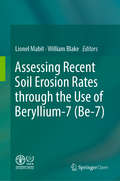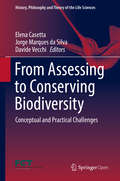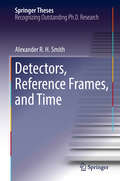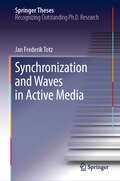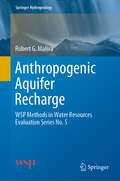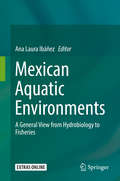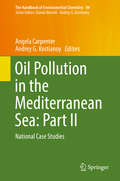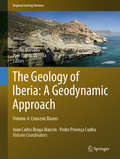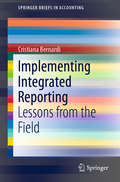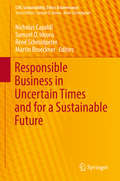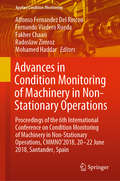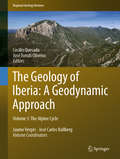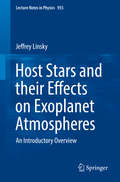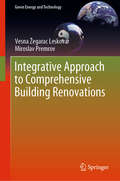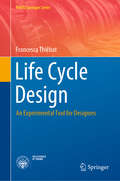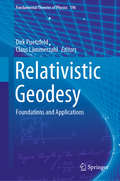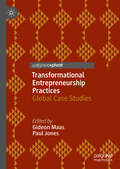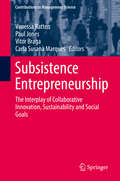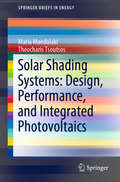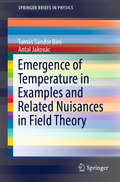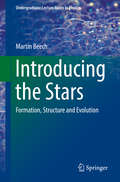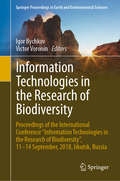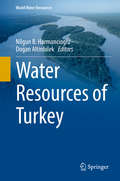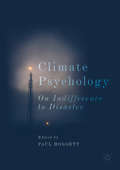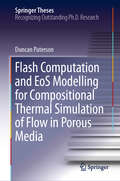- Table View
- List View
Assessing Recent Soil Erosion Rates through the Use of Beryllium-7 (Be-7)
by Lionel Mabit William BlakeThis open access book is the first comprehensive guideline for the beryllium-7 (Be-7) technique that can be applied to evaluate short-term patterns and budgets of soil redistribution in agricultural landscapes. While covering the fundamental and basic concepts of the approach, this book distinguishes itself from other publications by offering step-by-step instructions on how to use this isotopic technique effectively. It covers experimental design considerations and clear instruction is given on data processing. As accurate laboratory measurement is crucial to ensure successful use of Be-7 to investigate soil erosion, a full chapter is devoted to its specific determination by gamma spectrometry. This open access contribution further describes new developments in the Be-7 technique and includes a concluding chapter highlighting its potential benefits to support the implementation of area-wide soil conservation policy.
From Assessing to Conserving Biodiversity: Conceptual and Practical Challenges (History, Philosophy and Theory of the Life Sciences #24)
by Elena Casetta Jorge Marques da Silva Davide VecchiThis open access book features essays written by philosophers, biologists, ecologists and conservation scientists facing the current biodiversity crisis. Despite increasing communication, accelerating policy and management responses, and notwithstanding improving ecosystem assessment and endangered species knowledge, conserving biodiversity continues to be more a concern than an accomplished task. Why is it so?The overexploitation of natural resources by our species is a frequently recognised factor, while the short-term economic interests of governments and stakeholders typically clash with the burdens that implementing conservation actions imply. But this is not the whole story. This book develops a different perspective on the problem by exploring the conceptual challenges and practical defiance posed by conserving biodiversity, namely: on the one hand, the difficulties in defining what biodiversity is and characterizing that “thing” to which the word ‘biodiversity’ refers to; on the other hand, the reasons why assessing biodiversity and putting in place effective conservation actions is arduous.
Detectors, Reference Frames, and Time (Springer Theses)
by Alexander R. SmithThis thesis uses the tools of quantum information science to uncover fascinating new insights about the intersection of quantum theory and relativity. It is divided into three self-contained parts, the first of which employs detector models to investigate how the information content of quantum fields depends on spacetime curvature and global spacetime topology. The behavior of Unruh-DeWitt detectors on curved spacetimes are investigated, following which these detectors are used to probe the vacuum state of a scalar field in various topologies. This leads to a generalization of the entanglement harvesting protocol involving detectors in arbitrary curved spacetimes admitting a Wightman function. The second part extends the theory of quantum reference frames to those associated with noncompact groups. Motivated by the pursuit of a relational relativistic quantum theory where the group of reference frames is the Poincaré group, the author then generalizes a communication protocol between two parties lacking a common reference frame to the scenario where the group of transformations of their reference frame is a one-dimensional noncompact Lie group. Finally, the third part, inspired by theories of quantum gravity, generalizes the conditional probability interpretation of time, a proposed mechanism for time to emerge from a fundamentally timeless Universe. While the conditional probability interpretation of time is based upon conditioning a solution to the Wheeler-DeWitt equation on a subsystem of the universe that acts a clock, the author extends this approach to include an interaction between the system being used as a clock and a system whose evolution the clock is tracking.
Synchronization and Waves in Active Media (Springer Theses)
by Jan Frederik TotzThe interplay between synchronization and spatio-temporal pattern formation is central for a broad variety of phenomena in nature, such as the coordinated contraction of heart tissue, associative memory and learning in neural networks, and pathological synchronization during Parkinson disease or epilepsy. In this thesis, three open puzzles of fundametal research in Nonlinear Dynamics are tackled: How does spatial confinement affect the dynamics of three-dimensional vortex rings? What role do permutation symmetries play in the spreading of excitation waves on networks? Does the spiral wave chimera state really exist?All investigations combine a theoretical approach and experimental verification, which exploit an oscillatory chemical reaction. A novel experimental setup is developed that allows for studying networks with N > 1000 neuromorphic relaxation oscillators. It facilitates the free choice of network topology, coupling function as well as its strength, range and time delay, which can even be chosen as time-dependent. These experimental capabilities open the door to a broad range of future experimental inquiries into pattern formation and synchronization on large networks, which were previously out of reach.
Anthropogenic Aquifer Recharge: WSP Methods in Water Resources Evaluation Series No. 5 (Springer Hydrogeology)
by Robert G. MalivaThe book is an overview of the diversity of anthropogenic aquifer recharge (AAR) techniques that use aquifers to store and treat water. It focusses on the processes and the hydrogeological and geochemical factors that affect their performance. This book is written from an applied perspective with a focus of taking advantage of global historical experiences, both positive and negative, as a guide to future implementation. Most AAR techniques are now mature technologies in that they have been employed for some time, their scientific background is well understood, and their initial operational challenges and associated solutions have been identified. However, opportunities exist for improved implementation and some recently employed and potential future innovations are presented. AAR which includes managed aquifer recharge (MAR) is a very important area of water resources management and there is no recent books that specifically and comprehensively addresses the subject.
Mexican Aquatic Environments: A General View from Hydrobiology to Fisheries
by Ana Laura IbáñezPursuing a multidisciplinary approach, this book highlights current challenges in, and potential solutions to, environmental water management in Mexico. It includes an essential review of current literature and state of the art research, providing a one-stop resource for researchers, graduate students and environmental water managers alike. The result of a cooperation between 35 researchers from seven Mexican academic institutions, two Federal Commissions and one international organization, the book links science to practice for living organisms and their environment, while also addressing anthropogenic effects on our water ecosystems. Particularly the book addresses the following subjects: Biodiversity in inland waters, physical and chemical characterization of inland waters, physico-chemical characterization of Mexican coastal lagoons, microbiota in brackish ecosystems, diversity associated with southern Mexico’s pacific coral reefs, fry fish stockings in aquatic epicontinental systems, a review of tuna fisheries in Mexico, fishery resource management challenges stemming from climate change, aquatic invasive alien species, harmful algal blooms, and aquatic protected areas, related ecological and social problems and the importance for fisheries’ yield.
Oil Pollution in the Mediterranean Sea: National Case Studies (The Handbook of Environmental Chemistry #84)
by Angela Carpenter Andrey G. KostianoyThis volume reviews the oil inputs to the Mediterranean Sea from sources such as shipping, offshore oil installations, and oil refineries, presented in a number of national case studies. A regional overview is also presented for the Adriatic Sea. Topics include mapping of oil slicks in the Adriatic, oil exploration and exploitation activities in the waters of the Levantine Basin (Eastern Mediterranean), the oil pollution preparedness and response activities of individual Mediterranean states, bilateral and regional cooperation among the various states, and the risk of pollution from shipping in sensitive sea areas, for example. Together with the companion volume Oil Pollution in the Mediterranean Sea: Part I - The International Context, it addresses both national and international measures in the region, making it of relevance to the agencies and government bodies tasked with remediating or preventing oil pollution, as well as policymakers and practitioners in the fields of shipping, ports and terminals, oil extraction and marine management. It provides researchers with essential reference material on tools and techniques for monitoring oil pollution, and constitutes a valuable resource for undergraduate and post-graduate students in the field of marine oil pollution.
The Geology of Iberia: Volume 4: Cenozoic Basins (Regional Geology Reviews)
by Cecilio Quesada José Tomás OliveiraPursuing an innovative, global approach, this unique book provides an updated review of the geology of Iberia and its continental margins from a geodynamic perspective. Owing to its location close to successive plate margins, Iberia has played a pivotal role in the geodynamic evolution of the Gondwanan, Rheic, Pangea, Tethys and Eurasian plates over the last 600 Ma of Earth’s history. The geological record starts with the amalgamation of Gondwana in the Neoproterozoic, which was succeeded by the rifting and spreading of the Rheic ocean; its demise, which led to the amalgamation of Pangea in the late Paleozoic; the rifting and spreading of several arms of the Neotethys ocean in the Mesozoic Era and their ongoing closure, which was responsible for the Alpine orogeny. The significant advances in the last 20 years have increasingly attracted international interest in exploring the geology of the Iberian Peninsula. This volume focuses on the Cenozoic basins of the Iberian Geology and consequently the most recent sedimentary features in the Iberian Geology apart of the active ones. In this book, you will find a detailed explanation of the alpine foreland basins, the extension of the west Mediterranean as well as the latest magmatism in Iberia.
Implementing Integrated Reporting: Lessons from the Field (SpringerBriefs in Accounting)
by Cristiana BernardiSustainability, the environment, corporate accountability, social justice, integration – these are the buzzwords of our century. This book takes readers on a journey through the landscape of standard-setting giants and corporate reporting paradigms through the eyes of two companies that have taken very different paths toward integrated thinking. Both stories provide new insights into the transition to integrated reporting, as envisaged by the International Integrated Reporting Council (IIRC), and how integrated reporting is reshaping our views on transparency. However, the top-down approach adopted in studies of integrated reporting in practice has left many questions unanswered: Is it effective? How does it evolve into established practice? Is it just another management fad? This bottom-up critique answers all these questions and one more: Could integrated reporting become the corporate reporting norm? We shall see.Given its depth of coverage, the book appeals to IIRC academic community, participants in integrated reporting networks, and others interested in integrated reporting.
Responsible Business in Uncertain Times and for a Sustainable Future (CSR, Sustainability, Ethics & Governance)
by Nicholas Capaldi Samuel O. Idowu René Schmidpeter Martin BruecknerThis book offers up-to-date insights into the theory and practice of Corporate Social Responsibility (CSR) and sustainability management. Gathering contributions by a team of international scholars, it shares perspectives from a variety of academic disciplines, including management and tourism as well as accounting, higher education research and supply chain management. Guided by the credo of achieving 'Responsible Business for Uncertain Times and a Sustainable Future,' the authors present their latest reflections on, and possible solutions for, sustainable and responsible business practices. All of the contributions presented here are critical, evidence-based and solution-oriented, making the book both practical and insightful reading for academics and practitioners alike.
Advances in Condition Monitoring of Machinery in Non-Stationary Operations: Proceedings of the 6th International Conference on Condition Monitoring of Machinery in Non-Stationary Operations, CMMNO’2018, 20-22 June 2018, Santander, Spain (Applied Condition Monitoring #15)
by Alfonso Fernandez Del Rincon Fernando Viadero Rueda Fakher Chaari Radoslaw Zimroz Mohamed HaddarThis book is aimed at researchers, industry professionals and students interested in the broad ranges of disciplines related to condition monitoring of machinery working in non-stationary conditions. Each chapter, accepted after a rigorous peer-review process, reports on a selected, original piece of work presented and discussed at the International Conference on Condition Monitoring of Machinery in Non-stationary Operations, CMMNO’2018, held on June 20 – 22, 2018, in Santander, Spain. The book describes both theoretical developments and a number of industrial case studies, which cover different topics, such as: noise and vibrations in machinery, conditioning monitoring in non-stationary operations, vibro-acoustic diagnosis of machinery, signal processing, application of pattern recognition and data mining, monitoring and diagnostic systems, faults detection, dynamics of structures and machinery, and mechatronic machinery diagnostics.
The Geology of Iberia: Volume 3: The Alpine Cycle (Regional Geology Reviews)
by Cecilio Quesada José Tomás OliveiraTaking a new global approach, this unique book provides an updated review of the geology of Iberia and its continental margins from a geodynamic perspective. Owing to its location close to successive plate margins, Iberia has played a pivotal role in the geodynamic evolution of the Gondwanan, Rheic, Pangea, Tethys s.l. and Eurasian plates over the last 600 Ma of Earth's history. The geological record starts with the amalgamation of Gondwana in the Neoproterozoic succeeded by the rifting and spreading of the Rheic ocean; its demise, which led to the amalgamation of Pangea in the late Paleozoic; the rifting and spreading of several arms of the Neotethys ocean in the Mesozoic Era and their ongoing closure, which was responsible for the Alpine orogeny. The significant advances in the last 20 years have attracted international research interest in the geology of the Iberian Peninsula. This volume presents the most comprehensive, and updated description of the Alpine cycle in Iberia. This volume focuses in the different geological events during the Alpine orogeny as well as the lithological succession . This book is of interest not only for scientists of Portugal and Spain but also for geoscientists searching for analogies for oil and gas as well as tourists visiting the main mountain ridges of Iberia such as the Pyrenees.
Host Stars and their Effects on Exoplanet Atmospheres: An Introductory Overview (Lecture Notes in Physics #955)
by Jeffrey LinskyLike planets in our solar system, exoplanets form, evolve, and interact with their host stars in many ways. As exoplanets acquire material and grow to the final size, their atmospheres are subjected to intense UV and X-radiation and high-energy particle bombardment from the young host star. Whether a planet can retain its atmosphere and the conditions for significant mass loss both depend upon the strength of the host star's high-energy radiation and wind, the distance of the exoplanet from its host star, the gravitational potential of the exoplanet, and the initial chemical composition of the exoplanet atmosphere. This introductory overview describes the physical processes responsible for the emission of radiation and acceleration of winds of host stars that together control the environment of an exoplanet, focusing on topics that are critically important for understanding exoplanetary atmospheres but are usually not posed from the perspective of host stars. Accordingly, both host stars and exoplanets are not studied in isolation but are treated as integrated systems. Stellar magnetic fields, which are the energy source for activity phenomena including high-energy radiation and winds, play a critical role in determining whether exoplanets are habitable. This text is primarily for researchers and graduate students who are studying exoplanet atmospheres and habitability, but who may not have a background in the physics and phenomenology of host stars that provide the environment in which exoplanets evolve. It provides a comprehensive overview of this broad topic rather than going deeply into many technical aspects but includes a large list of references to guide those interested in pursuing these questions. Nonspecialists with a scientific background should also find this text a valuable resource for understanding the critical issues of contemporary exoplanet research.
Integrative Approach to Comprehensive Building Renovations (Green Energy and Technology)
by Vesna Žegarac Leskovar Miroslav PremrovThis book presents a new approach to building renovation, combining aspects of various professional disciplines, integrating green building design, structural stability, and energy efficiency. It draws attention to several often-overlooked qualities of buildings that should be comprehensively integrated into the context of building renovation.The book presents an overview of the most important renovation approaches according to their scope, intensity, and priorities. Combining basic theoretical knowledge and the authors’ scientific research it emphasizes the importance of simultaneous consideration of energy efficiency and structural stability in building renovation processes. It simultaneously analyses the effects of various renovation steps related to the required level of energy efficiency, while it also proposes the options of building extension with timber-glass upgrade modules as the solution to a shortage of usable floor areas occurring in large cities.This book offers building designers and decision makers a tool for predicting energy savings in building renovation processes and provides useful guidelines for architects, city developers and students studying architecture and civil engineering. Additionally, it demonstrates how specific innovations, e.g., building extensions with timber-glass modules, can assist building industry companies in the planning and development of their future production.The main aim of the current book is to expose various approaches to the renovation of existing buildings and to combine practical experience with existing research, in order to disseminate knowledge and raise awareness on the importance of integrative and interdisciplinary solutions.
Life Cycle Design: An Experimental Tool for Designers (PoliTO Springer Series)
by Francesca ThiebatThis book proposes an economic and environmental assessment tool to help private and public building designers and owners determine the global sustainability value of green buildings from a life cycle perspective. As it demonstrates, sustainable life cycle tools for building design and construction can help to achieve successfully integrated architecture. The first part of the book defines the relationship between environmental and economic aspects in a sustainable design approach and illustrates how life cycle methodologies, including Life Cycle Assessment and Life Cycle Costing, can be applied to life cycle design. Further, it highlights methods for calculating costs from LCA data, taking into consideration both discounted cash flow and external costs. In turn, the second part of the book presents an experimental design model, the Life Cycle Design Model (LCDM), which is based on a life cycle design approach that can be used to produce two different outcomes based on two assessment levels. The first assessment level involves creating a grid, called a Design Matrix, which is useful in the design process. The second assessment level involves drawing on LCA and LCC results to develop a user-friendly tool for designers and other actors involved in the building process so that they can assess the most sustainable design option using €CO, a factor that combines the environmental and energy effects of the building system with time and costs. Selected case studies illustrate the practical application of life cycle analysis and show how reflecting the environmental impacts and costs can improve the sustainability of buildings. The LCDM represents a transdisciplinary tool for the design team and, at the same time, allows information on users’ needs and building performance to be communicated between experts and non-experts.
Relativistic Geodesy: Foundations and Applications (Fundamental Theories of Physics #196)
by Dirk Puetzfeld Claus LämmerzahlDue to steadily improving experimental accuracy, relativistic concepts – based on Einstein’s theory of Special and General Relativity – are playing an increasingly important role in modern geodesy. This book offers an introduction to the emerging field of relativistic geodesy, and covers topics ranging from the description of clocks and test bodies, to time and frequency measurements, to current and future observations. Emphasis is placed on geodetically relevant definitions and fundamental methods in the context of Einstein’s theory (e.g. the role of observers, use of clocks, definition of reference systems and the geoid, use of relativistic approximation schemes). Further, the applications discussed range from chronometric and gradiometric determinations of the gravitational field, to the latest (satellite) experiments. The impact of choices made at a fundamental theoretical level on the interpretation of measurements and the planning of future experiments is also highlighted. Providing an up-to-the-minute status report on the respective topics discussed, the book will not only benefit experts, but will also serve as a guide for students with a background in either geodesy or gravitational physics who are interested in entering and exploring this emerging field.
Transformational Entrepreneurship Practices: Global Case Studies
by Gideon Maas Paul JonesPresenting an updated overview of transformational entrepreneurship, this book explores how critical concepts can be contextualised for different regions and countries, underlining the fact that no one system fits all. In order for entrepreneurship to play a role in socio-economic development, a balance needs to be struck between focusing on individual entrepreneurial activities and regions, and society-wide changes. Building on the Editors’ previous books, Systemic Entrepreneurship and Entrepreneurship Centres, this volume delves deeper into the importance of innovative eco-systems, providing examples of how transformational entrepreneurship can be implemented in different geographical locations. An invaluable read for policy-makers as well as scholars, the authors provide a series of detailed case studies from regions including the UK, Malaysia and Africa.
Subsistence Entrepreneurship: The Interplay of Collaborative Innovation, Sustainability and Social Goals (Contributions to Management Science)
by Paul Jones Vanessa Ratten Vitor Braga Carla Susana MarquesThis book focuses on the role of subsistence entrepreneurs in creating social and sustainable business opportunities on the global marketplace. Subsistence entrepreneurs use scarce resources to create new business opportunities, often in developing or emerging economies. In addition, subsistence entrepreneurship is increasingly being used as a way to facilitate market entry for small and medium-sized business enterprises that focus on collaborative innovation. The interdisciplinary contributions gathered here will expand readers’ understanding of the nature and characteristics of subsistence entrepreneurs, as well as the challenges they face. The central connection between subsistence, sustainability and social entrepreneurship is also explored.
Solar Shading Systems: Design, Performance, and Integrated Photovoltaics (SpringerBriefs in Energy)
by Maria Mandalaki Theocharis TsoutsosThis is the first book to describe the development of and state of the art in solar shading devices in buildings, detailing all methods of evaluating shading systems according to thermal and visual comfort. The issue of energy balance in buildings is gaining importance as conventional energy sources dwindle and become more expensive. As such, environmental concerns should be considered in overall design decisions. The book discusses the role sun control “machines” play in controlling solar and thermal radiation. It examines their geometry, their position in relation to glazing and their operation (in the cases of movable systems) to control the heat and light entering a building, as well as how their material and color influence their performance. This book appeals to architects and designers who are interested in efficient energy facade design.
Emergence of Temperature in Examples and Related Nuisances in Field Theory (SpringerBriefs in Physics)
by Antal Jakovác Tamás Sándor BiróField theory, relying on the concept of continuous space and time while confronted with the quantum physical nature of observable quantities, still has some fundamental challenges to face. One such challenge is to understand the emergence of complexity in the behavior of interacting elementary fields, including among other things nontrivial phase structures of elementary matter at high energy density or an atypical emergence of statistical properties, e.g., when an apparent temperature is proportional to a constant acceleration in a homogeneous gravitational field. Most modern textbooks on thermal field theory are mainly concerned with how the field theory formalism should be used if a finite temperature is given. In contrast, this short primer explores how the phenomenon of temperature emerges physically for elementary fields - inquiring about the underlying kinetic field theory and the way energy fluctuations and other noise should be handled - and it investigates whether and how this harmonizes with traditional field theory concepts like spectral evolution, the Keldysh formalism, and phase transitions.
Introducing the Stars: Formation, Structure and Evolution (Undergraduate Lecture Notes in Physics)
by Martin BeechThis textbook introduces the reader to the basic concepts and equations that describe stellar structure. Various approximation techniques are used to solve equations, and an intuitive rather than rigorous approach is employed to interpret the properties of the stars. The book provides step-by-step instructions, helpful exercises and relevant historical lessons to familiarize students with key concepts and mathematical theories.Based upon a series of one-semester (12 weeks) elective undergraduate courses offered at the University of Regina, this book is intended for students who are interested in seeing how basic calculus and introductory physics can be applied to the understanding of the stars from their formation to their death. The text provides an intermediate stepping stone between lower-level undergraduate classes and more specialized postgraduate texts on the subject of stellar structure.
Information Technologies in the Research of Biodiversity: Proceedings of the International Conference "Information Technologies in the Research of Biodiversity", 11–14 September, 2018, Irkutsk, Russia (Springer Proceedings in Earth and Environmental Sciences)
by Igor Bychkov Victor VoroninThis book offers a collection of papers presented at the First International Conference” Information Technologies in the Research of Biodiversity” that was held from 11-14 September 2018 in Irkutsk (Russia). Papers in this book cover areas of interaction of knowledge on biodiversity and information technologies. The main topics include: methods, models, software systems for the analysis of biodiversity data; global data portals; information and analytical systems on biodiversity; application of remote methods in vegetation mapping; theoretical fundaments and organization technologies of the information and telecommunications infrastructures.
Water Resources of Turkey (World Water Resources #2)
by Nilgun B. Harmancioglu Dogan AltinbilekThis book provides an in-depth description of water resources of Turkey, a country with a unique geographical location, extending from the Mediterranean in Europe to the Middle East. Its varying geography, topography, hydrology, geology and climate are reflected in the diverse characteristics of its water basins. Furthermore, due to its geographical location, Turkey has a significant number of transboundary river basins and has to share its water resources with its neighbors, an issue that can sometimes lead to water conflicts.Turkey is also an interesting example of a developing country that is attempting to adapt to universal water management strategies while at the same time facing legal, institutional, economic and capacity development problems. It has long remained a water-rich country, but the situation is now changing due to the increasing population, inefficient use of resources, and the impacts of climate change and environmental degradation.This book is useful for national and international organizations as well as water resources professionals. It takes on an added significance in the light of climate change in the region, water management problems and transboundary water basins.
Climate Psychology: On Indifference to Disaster (Studies in the Psychosocial)
by Paul HoggettThis book investigates the psycho-social phenomenon which is society’s failure to respond to climate change. It analyses the non-rational dimensions of our collective paralysis in the face of worsening climate change and environmental destruction, exploring the emotional, ethical, social, organizational and cultural dynamics to blame for this global lack of action. The book features eleven research projects from four different countries and is divided in two parts, the first highlighting novel methodologies, the second presenting new findings. Contributors to the first part show how a ‘deep listening’ approach to research can reveal the anxieties, tensions, contradictions, frames and narratives that contribute to people’s experiences, and the many ways climate change and other environmental risks are imagined through metaphor, imagery and dreams. Using detailed interview extracts drawn from politicians, scientists and activists as well as ordinary people, the second part of the book examines the many different ways in which we both avoid and square up to this gathering disaster, and the many faces of alarm, outrage, denial and indifference this involves.
Flash Computation and EoS Modelling for Compositional Thermal Simulation of Flow in Porous Media (Springer Theses)
by Duncan PatersonThis book investigates a wide range of phase equilibrium modelling and calculation problems for compositional thermal simulation. Further, it provides an effective solution for multiphase isenthalpic flash under the classical framework, and it also presents a new flash calculation framework for multiphase systems, which can handle phase equilibrium and chemical reaction equilibrium simultaneously. The framework is particularly suitable for systems with many phases and reactions. In this book, the author shows how the new framework can be generalised for different flash specifications and different independent variables. Since the flash calculation is at the heart of various types of compositional simulation, the findings presented here will promote the combination of phase equilibrium and chemical equilibrium calculations in future simulators, aiming at improving their robustness and efficiency.
